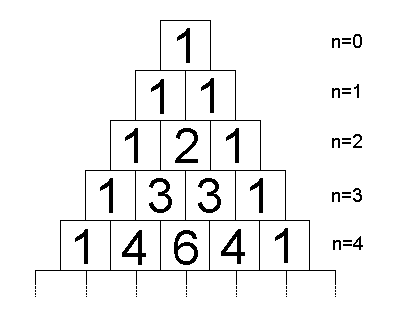
15-212-X : Homework Assignment 1
Due Wed Sep 10, 2:00 pm (electronically); papers at recitation.
Maximum Points: 50 (+10 extra credit)
First, the factorial function on natural numbers is defined mathematically as follows:
| 0! | = | 1 | |
| n! | = | n * (n-1)! | for n > 0 |
The factorial function is the basis for the first definition of binomial numbers. BN(n,r) denotes the binomial number for (n,r) or "n choose r". It is defined as follows:
| BN(n,r) | = | n! --------- r! (n-r)! |
for 0 <= r <= n |
A way to calculate binomial numbers which does not require factorials is to use Pascal's triangle. The triangle has a 1 at its top, every other number in the Pascal triangle is defined as the sum of the numbers to the right and to the left above. If there isn't any number, it counts as zero.

pascal and must have type int * int -> int .
Calculate the following values PT(5,3) and PT(7,1) .
pascal is a correct implementation of the binomial as
defined using factorials. Carefully state and check the boundary
conditions! You don't need to type your proof in (writing it by hand and
handing it in at recitation is usually faster and easier).
binomial
which uses factorials. This implementation is likely to lead to
rather frequent overflow exceptions. Test it to find some values of n and r
where the computation requires intermediate results which exceed the size
allowed by the machine representation of integers. Compare this to the
function pascal. Consider how you might define a function to
compute binomials based on multiplication which works for a larger set of
natural numbers. [Of course, eventually the result will be too large to be
representable with machine integers and no further improvement is possible
without another implementation of integers.]
A frequently used technique for computing transcendental functions is the Maclaurin series. It has the form
![]()
and approximates the function f near 0.
In the case of the exponential function, we obtain
![]()
This can be rewritten as
![]()
and implemented by the following function
fun exp3 (0, x, y) = y | exp3 (k, x, y) = exp3 (k-1, x, 1.0 + (x / real(k)) * y) fun exp0 (x:real) = exp3 (13, x, 1.0);
Here, exp0 approximates the exponential function near
0, using the first 13 terms of the Maclaurin series.
Prove that exp3(k,x,y) evaluates to
![]()
for k > 0.
The exp0 function is only accurate near 0. Assume
you want to rely on exp0 only for arguments between
0 and 1. Write a function exp : real -> real
which is accurate for arbitrary real arguments. You do not need
to prove the correctness of this function.
Compare the results of your function with the built-in function
Math.exp on a few values.
![]()
Proceed as above:
sin3 accurate near 0.
sin : real -> real which reduces arbitrary arguments to
the interval between 0 and pi/2.
Math.sin on a few values.
The second problem treats some computations with real numbers and functions over them. We will discuss and implement a method for numerical integration of functions of one argument. Numerical integration means, that we look for a good approximation of the integral, but not for a "closed form". Naturally, we cannot expect to guess the solution with the first approximation, therefore we must calculate a sequence of approximation values, each an improvement of the previous one. The idea behind this approximation is very simple: Consider the graph of a function

and an equi-distant partition of the x-axis between some points a and b. What happens if we calculate the area of the trapezoids below?

We expect to obtain an approximation value which is close to the integral. It is one of the easier theorems of Calculus that with finer partitions we can hope for a more refined approximation result.
Typically in search for a good approximation value, we continue this kind of splitting in the same fashion. The nth approximation value is hence determined by the sum of 2n rectangles. Next we must define a criteria for deciding when to stop with the partition refinement. Unfortunately, your program cannot access the "real" value of the integral, so we must define the criteria on the basis of the previous approximation value and the current value. We accept an approximation value if the absolute value of the difference between previous and current value is less then a given (positive) epsilon.
integrate : real -> (real -> real) -> (real * real) -> (int
* real) integrate epsilon f (a,b) approximates the integral of f
between a and b up to epsilon. It returns a a pair, where the first component
yields the current refinement level (n, not 2n), and the second the
approximation value, fulfilling the condition from above. Integrate
Hint: Use the context browser to access information about the
mathematical functions from the
Math structure.
integrate0 : (real -> real) -> (real -> real)
integrate0 f is the function g(x) which represents
the value of the integral of f between 0 and x, approximated with
bound epsilon.
/afs/andrew/scs/cs/15-212-X/studentdir/<your andrew id>/ass<number>